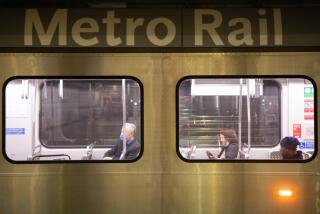MTA is trying to shed some wait
- Share via
Waiting for the bus at Normandie and Slauson avenues late one night, Betrona Casileo was getting nervous.
Thirty minutes. Forty minutes. Still no bus.
“At night, it’s very dangerous,” said Casileo, who is 52 and has been riding Metro buses for 15 years. “I was just hoping the bus would come.”
It did -- eventually.
Casileo isn’t the only frustrated passenger. Metro buses in Los Angeles are on time only 63% of the time, the lowest performance rate among 10 major metropolitan areas, according to a recent survey.
The Metropolitan Transportation Authority surveyed transit agencies in nine other regions -- including New York, Chicago and Boston -- and found the average on-time performance of their buses was 79%.
Metro’s on-time performance has continued to decline even as its fleet expanded, according to the survey, conducted in 2007 using data from the previous two years. Since 2005, the MTA has added 53 buses, but its on-time performance has dropped 4 percentage points.
“I’m always waiting. Always,” said Sandra Quintana at a bus stop Wednesday morning at Vermont and Slauson avenues. Quintana, 23 and a lifelong bus rider, said buses usually arrive 10 to 15 minutes late, especially in East Los Angeles.
Metro tracks timeliness at about 20,000 bus stops in Los Angeles, but because on-time performance varies by stop or line, it is unable to determine the average wait time, said Carolyn Flowers, Metro’s chief operations officer.
MTA officials said the decline in on-time performance cannot be attributed to any one factor, but they note that staffing has not kept up with the growth in service.
For a decade beginning in 1996, MTA spent more than $1 billion to buy buses, add service and cap fares under a consent decree to settle a civil rights lawsuit with bus riders. Though Metro has 147 more buses and 1 million more hours of service today than it did in 1996, the number of vehicle operations supervisors has remained almost stagnant, at about 60.
The survey reports that the ratio of supervisors to the number of buses, miles traveled and hours of service are each almost three times greater than those of the average metropolitan area surveyed.
A supervisor in Los Angeles oversees an average of 38.61 buses, nearly 1.4 million revenue vehicle miles and 113,000 service hours per year, whereas supervisors surveyed in the other regions on average each oversee 14.8 buses, 409,000 revenue vehicle miles and 40,000 hours per year.
“What you see over time in the budgets of the MTA has been a real reluctance to add new positions,” said Los Angeles City Councilman Bernard Parks, who sits on Metro’s board of directors. “It got to the point where there was a major efficiency gap, or at least a perception of a gap, without these positions.”
The board voted Thursday to add 10 supervisors to monitor operations and service on the busiest lines with high complaints and low on-time performance. The motion -- brought forward last month by Parks, Long Beach City Councilwoman Bonnie Lowenthal and Los Angeles County Supervisor Yvonne Burke -- is an effort to bring Metro closer to its on-time goal of 70%.
Metro officials say they have not quantified how much the 10 extra supervisors will improve on-time performance, but board members said they’re hopeful bus service and ridership will also improve.
Bus riders make up more than 80% of all Metro boardings, but ridership last month was down 5.37% compared with May 2007. Metro rail ridership, on the other hand, increased 6% in May over the same period last year.
MTA officials say fare increases last year are partly to blame for the decline, but Flowers said the agency is starting to see a recovery. “Since January . . . bus ridership has increased 12%,” she said. “Bus ridership is coming back.”
Still, board members said improving on-time performance is crucial if Metro wants to attract riders. “It doesn’t matter how many buses you have if they’re not running on time,” Lowenthal said. “When people know they can rely on a bus, they’re more likely to use it.”
On-time performance is consistently a top complaint among bus riders, according to MTA reports.
The addition of 10 supervisors would cost $900,000 -- money that MTA officials say will come from reducing the amount of overtime supervisors currently log.
Flowers said the addition would be budget-neutral. She and bus riders acknowledge, however, that improving ridership satisfaction requires more than on-time service and more operations supervision.
More MTA supervisors “could help,” said Elizabeth Medrano, 31, who hops on eight to 12 Metro buses every day. “But what would help more is more money spent on the bus system.”
--
More to Read
Sign up for Essential California
The most important California stories and recommendations in your inbox every morning.
You may occasionally receive promotional content from the Los Angeles Times.













